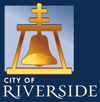One of the most important aspects of caring for Riverside’s trees is to ensure an ongoing heritage of appropriately planted trees for future generations. All trees planted must conform to the Master Urban Forest Plan, which designates the species of City trees to be planted on each street.
Tree planting requires planning. The Urban Forestry Policy guidelines were designed to provide optimum tree selection in order to reduce future problems and expense. The guidelines are used to facilitate the species selection based on a review of tree size at maturity as well as physical characteristics. Each neighborhood block has been evaluated and designated species have been chosen and approved by the Park and Recreation Commission to ensure that the right tree is planted in the right place.
The Urban Forestry Policy takes into consideration the full size of a tree at maturity and whether it will fit the growing space. Other characteristics considered are the tree’s growth rate, litter from fruit or leaves, insect or disease problems, water needs, temperature hardiness, soil requirements, aesthetics and design criteria. Another reason for a plan is to make certain that there are never too many trees of one species in an area of the City or Citywide. Large populations of one tree species may be lost during an insect or disease epidemic.
Many streets in Riverside are designated with more than one species. This will help reduce the spread of insects and disease on a block-by-block basis and decrease the potential for losing entire populations of a specific species in the case of a pest epidemic. Along streets which have mature trees of a single species which provide a closed canopy, such as Camphors, or otherwise provide a special aesthetic quality, the single designated species will be maintained whenever appropriate. The following pages describe the guidelines for determining a designated species for a street.
The following should be considered when designating species for a new City street or for revising the Urban Forestry Policy:
No more than 5% of the total trees in Riverside will be any one species. Trees that urrently comprise more than 5% of Riverside’s public trees are:
· Mexican Fan Palm (Washingtonia robusta)
· California Fan Palm (Washingtonia filifera)
· Crape Myrtle (Lagerstroemia indica)
· Shamel Ash (Fraxinus udei)
· Holly Oak (Quercus ilex)
General tree characteristics to be encouraged are (not listed by priority):
· Drought tolerance
· Heat tolerance
· Minimal allergy problems (pollen production)
· Native to California
· Minimal root damage potential
· Long life span
· Good branch strength and structure
· No major insect/disease problems
· Good cold tolerance
· Low maintenance
· Large shading potential
· Future wood utilization/recycling potential
· Low amount of natural hydrocarbon production
· No messy fruit/other plant parts
· Showy flowers
Replacement tree species shall be selected by the Public Works Department based on site conditions and tree planting guidelines.

